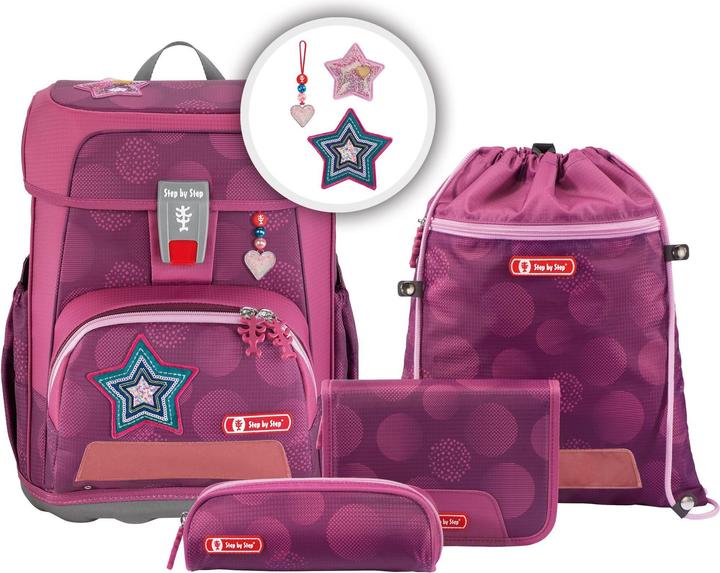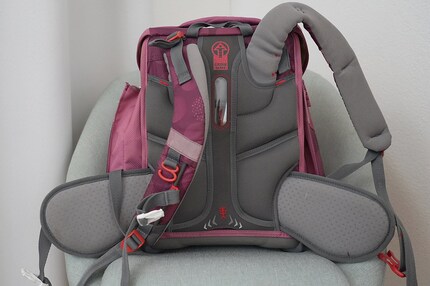

Expensive school rucksacks: loaded with unnecessary bells and whistles
School rucksacks for kids cost a small fortune. Why? That’s exactly what I wanted to know from a leading manufacturer. After a year with a schoolchild, I’ve experienced that a school rucksack isn’t worth its hefty price.
That was the one she wanted and no other. The purple one with pink dots and – of course – magnetic glitter stars. My daughter had seen this school rucksack and was adamant that this was the one for her.
With the oversized thing on her back and glowing eyes, she strutted through the shop. I looked at the price tag and was in for a surprise. Almost 300 francs. Ouch.

A hefty price, but no exception. These days, a regular school rucksack costs between 250 and 350 francs. Of course, there are cheaper models by less famous brands. But kids usually want what their peers have – and the vast majority doesn’t have a no-name rucksack.
As a parent, godfather or godmother, you’ll get out the big purse without resistance.
The Galaxus sales figures are proof of this, as the best-selling school rucksacks for kids are by Step by Step and Ergobag, followed by Satch, Beckmann and Herlitz. All these models have one thing in common – they’re super expensive. Nevertheless, as a parent, godfather or godmother, you’ll get out the big purse without resistance. After all, you want your kid’s first school rucksack to be something very special. And new.
Only the best for our kids
You spend a small fortune and what does your child get? Well, the very best and healthiest rucksack – and tons of bells and whistles. In our case:
- a school rucksack made from 100 percent recycled plastic bottles
- a spacious main compartment and integrated book compartment for ergonomic placement of heavy objects
- a lid with magnetic closure, which is very easy to open and closes again by itself
- two open side pockets
- an electric waist belt that adjusts to the size of the child’s waist to distribute the weight and relieve the shoulders
- two infinitely height-adjustable shoulder straps via a swivel mechanism inside the rucksack
- a height-adjustable chest strap
- Easy Grow System that can be adjusted to the body size
- an ergonomically shaped back pad
- reflective stripes on the front, sides and shoulder straps
- an insulated front pocket with zipper for snacks
- an address compartment
- a timetable in the top flap
- two magnetic interchangeable motifs
- a sports bag that can be attached to the rucksack at the touch of a button
- a case filled with branded products
- a small pencil case
- a tag
- four-year warranty
That doesn’t sound like a school rucksack. That sounds like a miracle machine.
I read the product description and can’t help but laugh. That doesn’t sound like a school rucksack. That sounds like a miracle machine. And it kind of is.
150 individual parts assembled by hand
I talked to a manufacturer of school rucksacks for kids and found out how well thought-out such rucksacks are and how much effort goes into producing them. A model by the brand Step by Step consists of around 150 individual parts, says Ann-Christin Becker from the marketing department of the German school rucksack producer. Assembling them is complicated, so most of the work is still done by hand. «From designing it to having a finished school rucksack in front of you, it takes about twelve months. In total, over 100 people work on each rucksack.»

Source: Katja Fischer
The time and effort that goes into it, the numerous functions, the adjustability, the high-quality workmanship, but also the robust and durable materials all contribute to the price. «These school rucksacks are made to be used for four years,» says the marketing specialist. The sustainable production and the good working conditions of those who make the bags also have an impact on the price. «We fully offset CO₂ emissions so that we keep our environmental footprint as low as possible.»
OK, you’ve won me over. I understand why such a rucksack would cost a lot. But I still don’t get why it needs all those features.
Too light and too big
In other words, do kids need such sophisticated school rucksacks? My daughter has just finished her first year at school and from what I’ve seen so far, I dare to say: not at all. All the high-tech and add-ons aren’t necessary.
Of course, seven-year-olds should take care of their young backs. Absolutely. An ergonomic rucksack and adjustable straps calibrated to their body and distribute the weight evenly. That’s great. But – which weight? Their snacks? The weight of their homework? During her entire first year of school, my daughter never carried home more than two sheets of paper or a notebook. Heavy textbooks? Nope. The rucksack has to carry no more than the weight of a book every now and then – when my daughter gets another friendship book to fill in.
According to Ann-Christin Becker from Step by Step, this is a cultural difference between Switzerland, Germany and Austria. «In Switzerland, kids don’t seem to have to carry a lot of things to school.» «In Germany and Austria, it’s not uncommon for the little ones to be carrying over five kilogrammes of things around with them.»
The only things my daughter is lugging around quite regularly (aside from some featherweight assignment sheets) are a few stuffed animals, sweets, rubbish, and lucky stones. How come? Well, she has so much empty space in her rucksack that she stuffs it with things that don’t belong there. She’s turned her school rucksack into a smuggling vehicle. And I’m her secret declutterer.
She’s turned her school rucksack into a smuggling vehicle. And I’m her secret declutterer.
Objections? Well, you might say she’ll be getting more and more homework in the coming years and will have to carry more things to school and back. Indeed. But it’s likely that she’ll have a new school rucksack by then. I’m told by other parents that they last about three years. That’s when kids want a new, hipper model. Or a regular rucksack. Long live longevity.
Retro school rucksack in great condition for sale
When I chose my own school rucksack more than 30 years ago, longevity was the main criteria. It couldn’t be pink («That won’t be your favourite colour for long») nor feature childish motifs («You won’t like that anymore when you’re older») So I decided to go with a timeless, but incredibly boring red leather school rucksack.
It served its purpose. And I actually still have it. Apart from a few spots and wrinkles on the leather, it’s aged gracefully. It would serve well for a few more years. Should I give my second daughter... Alright, let’s not go there.
Out of curiosity, however, I checked whether these high-tech-free retro rucksacks from back then are still made. Yes, they are. But they also cost a small fortune – about 300 francs. Well, then I’d rather get one with an Easy Grow System and ergonomically shaped back padding for the same price.

Source: Katja Fischer
Header image: Katja Fischer
Mom of Anna and Elsa, aperitif expert, group fitness fanatic, aspiring dancer and gossip lover. Often a multitasker and a person who wants it all, sometimes a chocolate chef and queen of the couch.
This is a subjective opinion of the editorial team. It doesn't necessarily reflect the position of the company.
Show all

